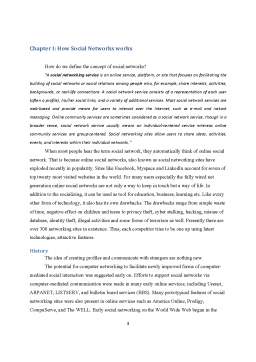Cuprins
- Chapter I: How Social Networks works 4
- History 4
- So how it’s working? 5
- The main social networks 7
- Classification of social networks 8
- Compare the social networks based on the literature 10
Extras din proiect
Chapter I: How Social Networks works
How do we define the concept of social networks?
“A social networking service is an online service, platform, or site that focuses on facilitating the building of social networks or social relations among people who, for example, share interests, activities, backgrounds, or real-life connections. A social network service consists of a representation of each user (often a profile), his/her social links, and a variety of additional services. Most social network services are web-based and provide means for users to interact over the Internet, such as e-mail and instant messaging. Online community services are sometimes considered as a social network service, though in a broader sense, social network service usually means an individual-centered service whereas online community services are group-centered. Social networking sites allow users to share ideas, activities, events, and interests within their individual networks.”
When most people hear the term social network, they automatically think of online social network. That is because online social networks, also known as social networking sites have exploded recently in popularity. Sites like Facebook, Myspace and LinkedIn account for seven of top twenty most visited websites in the world. For many users especially the fully wired net generation online social networks are not only a way to keep in touch but a way of life. In addition to the socializing, it can be used as tool for education, business, learning etc. Like every other form of technology, it also has its own drawbacks. The drawbacks range from simple waste of time, negative effect on children and teens to privacy theft, cyber stalking, hacking, misuse of database, identity theft, illegal activities and some forms of terrorism as well. Presently there are over 300 networking sites in existence. Thus, each competitor tries to be one up using latest technologies, attractive features.
History
The idea of creating profiles and communicate with strangers are nothing new.
The potential for computer networking to facilitate newly improved forms of computer-mediated social interaction was suggested early on. Efforts to support social networks via computer-mediated communication were made in many early online services, including Usenet, ARPANET, LISTSERV, and bulletin board services (BBS). Many prototypical features of social networking sites were also present in online services such as America Online, Prodigy, CompuServe, and The WELL. Early social networking on the World Wide Web began in the form of generalized online communities such as Theglobe.com (1995), Geocities (1994) and Tripod.com (1995). Many of these early communities focused on bringing people together to interact with each other through chat rooms, and encouraged users to share personal information and ideas via personal webpages by providing easy-to-use publishing tools and free or inexpensive webspace. Some communities - such as Classmates.com - took a different approach by simply having people link to each other via email addresses. In the late 1990s, user profiles became a central feature of social networking sites, allowing users to compile lists of "friends" and search for other users with similar interests. New social networking methods were developed by the end of the 1990s and many sites began to develop more advanced features for users to find and manage friends. This newer generation of social networking sites began to flourish with the emergence of SixDegrees.com in 1997,[13] followed by Makeoutclub in 2000, Hub Culture and Friendster in 2002, and soon became part of the Internet mainstream. Friendster was followed by MySpace and LinkedIn a year later, and eventually Bebo. Attesting to the rapid increase in social networking sites' popularity, by 2005, it was reported that MySpace was getting more page views than Google. Facebook, launched in 2004, became the largest social networking site in the world in early 2009.
So how it’s working?
How do the social networks manage millions of users and hundreds of millions of updates? The answers lie in open-source software and thousands of servers. Let's take a look on a few top social networks -- Twitter, LinkedIn, Facebook, and MySpace -- and see exactly how they do this.
The networks don't want to share all their secrets on how they actually work their social magic. An example is Twitter. We know that is famous or infamous in some circles, for its use of Ruby on Rails an easy-to-use, open-source Web framework, as its foundation. To route its millions of daily messages, Twitter uses the open-source Jabber/XMPP (Extensible Messaging and Presence Protocol) instant messaging.
For the most part, that social networks use a lot of programs, application, open – sources, because they have to handle all their users’ demands. They need stability. For example Twitter with its ”Fail Whale” was down 84 hours in 2008. LinkedIn came in second in this race to the bottom with 45.8 hours of down time.
But others are doing better. Facebook, for example, only had 7.2 hours of downtime in 2008, despite a claimed server load of more than 35 million users updating their status at least once each day.
An example of open – source program is Mamcached, and this was created by programmers to deal with the massive data requirements of dynamic social networks applications.
This it is used now by Facebook, Twitter, and many others, and was build from the ground up.
Preview document
Conținut arhivă zip
- Social Networks.docx



















